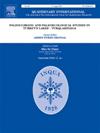Provenance geochemical detection of soil deposits from archaeological limestone caves in the Bubing Basin, tropical China
IF 1.9
3区 地球科学
Q3 GEOGRAPHY, PHYSICAL
引用次数: 0
Abstract
Today, the limestone karst cave systems in southern China are extensive and well developed. Due to the slow uplift of the crust since the Neogene and extensive river downcutting that made these caves accessible, the sediments in these karst caves preserve a plethora of Quaternary vertebrate fossils (including hominins) and occasionally stone artifacts. These remains provide important clues for studying the paleontology, archaeology and paleoenvironment in the region. However, in these caves it is difficult to understand how these fossils were deposited. In fact, it is often extremely difficult to determine the provenance and transport history of homogeneous clastic sediments, which may carry these fossils and artifacts into these caves, because they often do not have distinct sedimentological features. Here we present a provenance analysis of the Pleistocene clastic sediments from Chuifeng, Mohui, Ganxian and Luna Caves, four caves that may be considered representative of the basin, and compared with the sediment samples from the local fluvial terraces and the surface of limestone hills in Bubing Basin, Guangxi, southern China, utilizing their major and trace element composition as a provenance marker. The major, trace element ratios, and rare earth element distribution data all indicate that the clastic sediments of these four cave sites are directly derived from the weathered residual sediments found on the limestone hills where these caves are located. In all cases, the cave deposits are clearly different from the clastic sediments from the four local fluvial terraces in the basin. Our results provide a new set of data that complement and further expands the common view that these clastic sediments and encased mammal fossils are transported into these cave sites by fluvial action. The clastic sediments on these limestone hills are primarily transported into the caves through cave entrances and/or pipeline or fractures in the hills by sheet flow. As such, it is likely that biological agents (e.g., porcupine and/or carnivore/hominin transport) and not fluvial activity may have played an even greater role in the accumulation of vertebrate fossils in cave sites than traditionally thought. This study should have broader implications in investigations into the relationship between clastic sediments and fossils in cave sites across time and space.
热带布兵盆地考古石灰岩溶洞土壤沉积物物源地球化学检测
今天,中国南方的石灰岩溶洞系统广泛而发达。由于自新近纪以来地壳的缓慢隆起和广泛的河流下游使得这些洞穴可以进入,这些喀斯特洞穴中的沉积物保存了大量的第四纪脊椎动物化石(包括人类)和偶尔的石器制品。这些遗存为研究该地区的古生物学、考古学和古环境提供了重要线索。然而,在这些洞穴中,很难理解这些化石是如何沉积的。事实上,由于碎屑沉积物往往没有明显的沉积学特征,因此确定它们的来源和搬运历史往往是极其困难的,这些碎屑沉积物可能会将这些化石和人工制品带入这些洞穴。本文对具有盆地代表性的垂峰洞、墨会洞、干仙洞和月月洞的更新世碎屑沉积物进行了物源分析,并与广西布兵盆地当地河流阶地和石灰岩丘陵表面的沉积物样品进行了对比,以其主量元素和微量元素组成作为物源标志。主要元素比、微量元素比和稀土元素分布数据均表明,这4个洞穴遗址的碎屑沉积物直接来源于洞穴所在石灰岩山丘上发现的风化残余物。在所有情况下,洞穴沉积物与盆地内四个局部河流阶地的碎屑沉积物明显不同。我们的结果提供了一组新的数据,补充并进一步扩展了这些碎屑沉积物和包裹的哺乳动物化石是通过河流作用进入这些洞穴遗址的共同观点。这些石灰岩山上的碎屑沉积物主要通过岩洞入口和(或)山体中的管道或裂缝以片状流的形式被输送到岩洞中。因此,生物因素(例如,豪猪和/或食肉动物/人类运输),而不是河流活动,可能在洞穴遗址中脊椎动物化石的积累中发挥了比传统认为的更大的作用。这一研究成果将对跨时空研究岩洞遗址碎屑沉积物与化石的关系具有更广泛的指导意义。
本文章由计算机程序翻译,如有差异,请以英文原文为准。
求助全文
约1分钟内获得全文
求助全文
来源期刊

Quaternary International
地学-地球科学综合
CiteScore
5.60
自引率
4.50%
发文量
336
审稿时长
3 months
期刊介绍:
Quaternary International is the official journal of the International Union for Quaternary Research. The objectives are to publish a high quality scientific journal under the auspices of the premier Quaternary association that reflects the interdisciplinary nature of INQUA and records recent advances in Quaternary science that appeal to a wide audience.
This series will encompass all the full spectrum of the physical and natural sciences that are commonly employed in solving Quaternary problems. The policy is to publish peer refereed collected research papers from symposia, workshops and meetings sponsored by INQUA. In addition, other organizations may request publication of their collected works pertaining to the Quaternary.
 求助内容:
求助内容: 应助结果提醒方式:
应助结果提醒方式:


